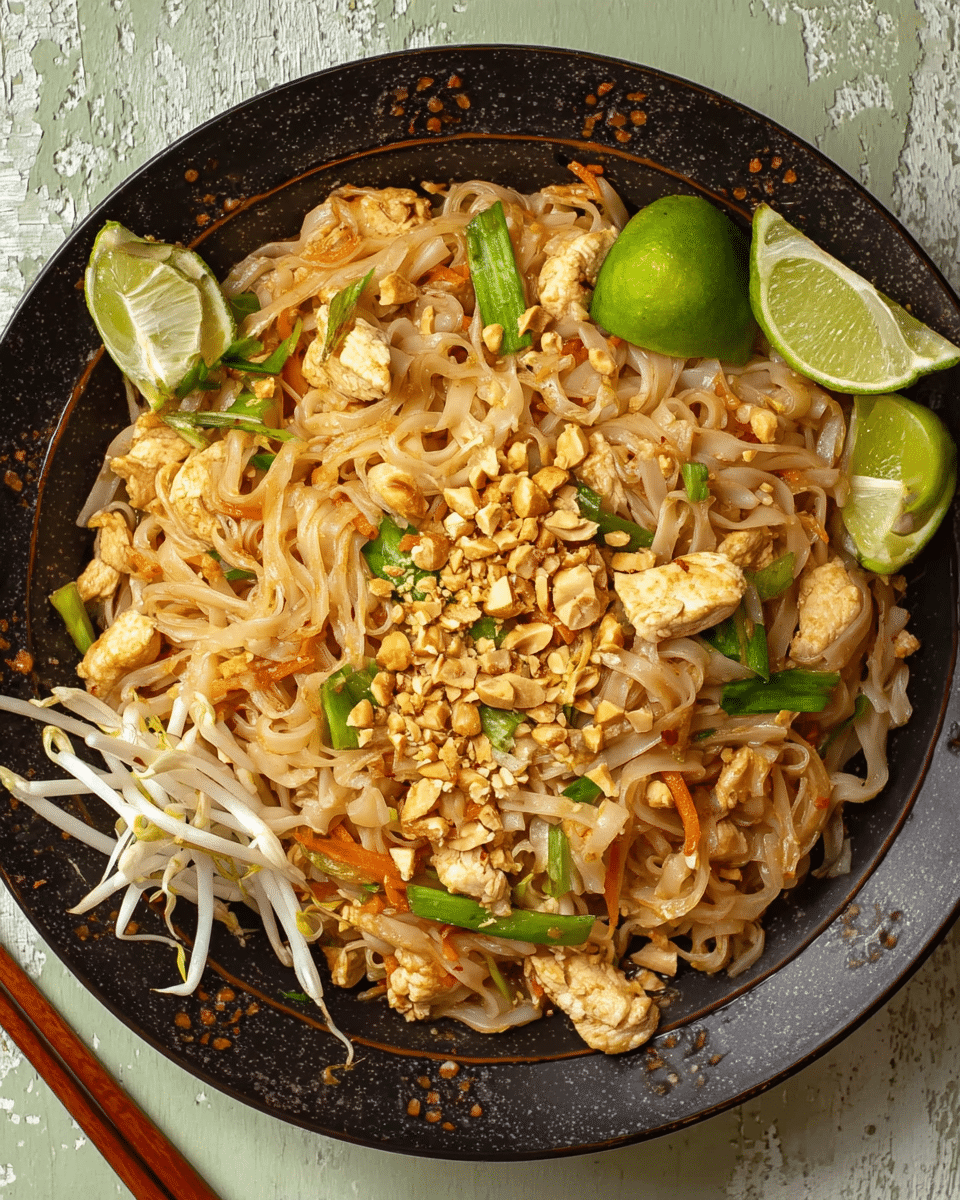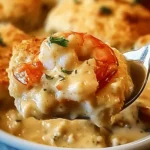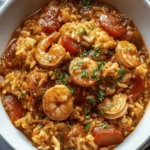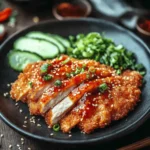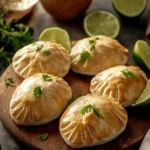The blend of tamarind, fish sauce, and lime creates a tangy, savory sweet sauce that’s perfectly balanced. Tossed with chewy rice noodles, golden chicken, crisp veggies, and roasted peanuts, this Pad Thai is a delicious harmony of textures and flavors.
Perfect for busy weeknights or when you’re craving restaurant-style Thai at home, this dish comes together in under 30 minutes. It’s versatile, vibrant, and endlessly satisfying. Garnish with fresh lime wedges and a sprinkle of peanuts for an authentic finish that will have everyone asking for seconds.
Full Recipe:
Ingredients:
For the Sauce:
-
¼ cup tamarind paste
-
¼ cup fish sauce
-
⅓ cup brown sugar (packed)
-
2 tablespoons soy sauce
-
Juice from 1 lime
-
¼ teaspoon red pepper flakes
For the Pad Thai:
-
10 ounces rice noodles
-
3 tablespoons vegetable oil (divided)
-
1 pound boneless, skinless chicken breast, thinly sliced
-
1 cup bean sprouts
-
1 medium carrot, julienned or shredded
-
4 cloves garlic, minced
-
3 large eggs, lightly beaten
-
½ cup roasted peanuts, chopped
-
3 green onions, sliced into 1-inch pieces
-
Lime wedges for serving
Directions:
-
In a small bowl, whisk together tamarind paste, fish sauce, brown sugar, soy sauce, lime juice, and red pepper flakes. Set aside.
-
Cook the rice noodles according to the package instructions. Drain, rinse under cold water, and toss with 1 tablespoon of vegetable oil.
-
Heat 1 tablespoon of oil in a large skillet or wok over medium-high heat. Add the chicken and sauté for 3–5 minutes until golden and cooked through. Remove and set aside.
-
Add another tablespoon of oil to the same skillet. Sauté bean sprouts, julienned carrot, and garlic for 2 minutes. Push to the side of the pan.
-
Add beaten eggs to the other side and scramble until cooked through. Mix eggs with the veggies.
-
Return chicken to the pan. Add noodles, prepared sauce, and chopped peanuts. Toss everything gently to combine and coat evenly.
-
Stir in green onions and remove from heat.
-
Serve hot with extra peanuts, red pepper flakes, and lime wedges on the side.
Prep Time: 15 minutes | Cooking Time: 15 minutes | Total Time: 30 minutes
Kcal: 756 kcal | Servings: 4 servings
The Delicious Story of Pad Thai: A Sweet, Tangy Staple of Thai Cuisine
If there’s one dish that has become the hallmark of Thai cuisine outside of Thailand, it’s undoubtedly Pad Thai. With its perfect harmony of sweet, sour, salty, and umami, Pad Thai has not only captured global palates but has also woven itself into the culinary fabric of countless home kitchens.
Although it may seem like a humble noodle stir-fry at first glance, Pad Thai is deeply rooted in history, shaped by Thai culture and foreign influences, and beloved for its adaptability. From street vendors in Bangkok to gourmet kitchens across the world, it remains one of the most iconic and approachable Thai dishes.
The Origins of Pad Thai
Pad Thai, known in Thai as Phat Thai (ผัดไทย), translates to “Thai stir-fry.” Interestingly, it didn’t become widespread in Thailand until the mid-20th century. Its popularity can be traced back to a period of national modernization under Prime Minister Plaek Phibunsongkhram in the 1930s and 1940s. In an effort to promote Thai nationalism, reduce the country’s reliance on rice exports, and foster a unique cultural identity, the government popularized Pad Thai as a national dish.
While the use of rice noodles originally came from Chinese immigrants, the Thai people adapted the dish to reflect their own flavor profile emphasizing balance, aromatics, and freshness. Thus, Pad Thai as we know it today became a culinary symbol of Thailand’s evolving identity: proudly local, but with global roots.
The Flavor Symphony of Pad Thai
One of the reasons Pad Thai is so beloved is its exquisite balance of taste. Every bite captures a dynamic interplay between flavors:
-
Sweetness comes from palm sugar or brown sugar, which caramelizes slightly when stir-fried, giving depth to the dish.
-
Tanginess is delivered by tamarind paste the heart and soul of authentic Pad Thai which adds a fruity, sour edge that balances the other flavors.
-
Saltiness is layered in through fish sauce and/or soy sauce, creating a rich umami backbone.
-
Heat from red pepper flakes or Thai chilies brings that unmistakable kick, customizable to personal tolerance.
-
Nutty crunch from roasted peanuts sprinkled on top provides contrast in texture and richness.
-
Freshness is added by bean sprouts, lime wedges, green onions, and herbs like cilantro or Thai basil.
The result is a dish that’s not only delicious but endlessly satisfying it awakens the taste buds, warms the soul, and leaves you wanting more.
Pad Thai’s Cultural and Social Significance
Pad Thai is more than just a plate of noodles it’s a representation of Thailand’s culinary pragmatism and its people’s respect for balance and harmony. Across Thailand, Pad Thai is served in everything from roadside stalls and floating markets to casual eateries and upscale restaurants.
It’s often cooked in open-air kitchens, the aromatic steam drawing crowds of hungry patrons. For many locals, Pad Thai is comfort food affordable, quick, and satisfying while for tourists, it’s often the gateway dish to exploring the broader and more complex world of Thai cuisine.
Interestingly, Pad Thai also symbolizes adaptability. Whether served with shrimp, chicken, tofu, or vegetables, it remains inherently Thai, yet it allows each cook to personalize it something that aligns beautifully with Thailand’s culinary ethos of creativity and resourcefulness.
Customizing Pad Thai: A Dish for Every Diet
One of the reasons Pad Thai remains so popular is its incredible versatility. While the traditional version includes chicken or shrimp, eggs, fish sauce, and peanuts, it can easily be adapted to suit various dietary needs:
1. Vegetarian or Vegan Pad Thai
Replace fish sauce with soy sauce or tamari, and use tofu instead of meat. Ensure tamarind paste is free of animal-derived additives, and skip the eggs if desired.
2. Gluten-Free Pad Thai
Most rice noodles are naturally gluten-free, but make sure the soy sauce and tamarind paste used are certified gluten-free. Tamari is an excellent substitute.
3. Low-Carb or Keto Pad Thai
Though traditionally made with rice noodles, zucchini noodles (zoodles), shirataki noodles, or spaghetti squash can be used for a lower-carb variation. These still carry the sauce well and offer a creative spin on the classic.
4. High-Protein Pad Thai
Add grilled shrimp, extra chicken, or scrambled egg whites to boost protein content without compromising flavor.
The customization possibilities make Pad Thai a go-to dish not only for Thai food purists but also for modern eaters with diverse nutritional goals.
Cooking Tips for Better Pad Thai
Pad Thai is a quick-cooking dish that rewards preparation and timing. Here are a few pro tips for nailing it at home:
-
Prep everything first. The process moves fast, so chop, whisk, and soak everything before you turn on the heat.
-
Don’t overcook the noodles. They should be soaked or boiled just until pliable. They’ll finish cooking in the sauce.
-
Use a large pan or wok. This gives enough room to toss everything evenly and prevent steaming.
-
Balance the sauce. The holy grail of Pad Thai is in its sauce. Adjust sugar, lime, and fish sauce according to your taste.
-
Garnish generously. A handful of chopped peanuts, fresh lime wedges, green onions, and chili flakes take the dish from good to unforgettable.
Pairings and Serving Ideas
Pad Thai is incredibly satisfying on its own, but it also pairs beautifully with other Thai-inspired sides or beverages:
-
Appetizers: Try serving it alongside Thai spring rolls, crispy wontons, or mango salad for a refreshing contrast.
-
Drinks: Thai iced tea, lemongrass iced water, or even a light lager make great drink pairings.
-
Condiments: Add a side of Thai chili vinegar, sambal, or extra lime for guests to customize their experience.
-
Dessert: End with something light and sweet like mango sticky rice or coconut milk tapioca pudding.
Nutrition Profile: What’s in a Bowl?
A classic serving of Pad Thai can pack around 700–800 calories, depending on portion size and protein. It provides a great balance of macronutrients:
-
Carbohydrates: Rice noodles offer energy, while bean sprouts and carrots add fiber.
-
Protein: Chicken, shrimp, tofu, and eggs contribute substantial protein.
-
Fats: Peanuts and cooking oil provide healthy fats though moderation is key.
-
Vitamins: Thanks to the fresh herbs, garlic, lime, and vegetables, Pad Thai delivers antioxidants and vitamins A and C.
For a more nutrient-dense version, load up on veggies, reduce the sugar, and use lean protein.
Why Pad Thai Is Here to Stay
Pad Thai continues to be one of the world’s favorite noodle dishes because it’s accessible, rich in flavor, and full of cultural character. Whether you’re a beginner in the kitchen or an experienced home chef, this dish offers something special a quick yet soul-satisfying meal that can be tailored to your tastes.
Its wide appeal makes it ideal for both family dinners and dinner parties, and its vibrant, colorful appearance ensures it always looks as good as it tastes.
Conclusion:
Pad Thai is more than just a dish it’s a sensory experience, a cultural journey, and a culinary playground. Its harmonious flavor profile, storied history, and limitless customizability make it a standout in any kitchen. Whether you’re cooking it for the first time or the fiftieth, Pad Thai delivers comfort, connection, and a celebration of Thai culinary artistry.
So next time you whip up a batch, take a moment to appreciate everything that goes into those deliciously tangled noodles the history, the culture, and the balance that makes it all so irresistibly Thai.

